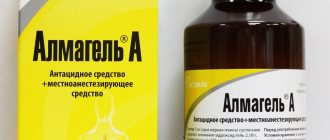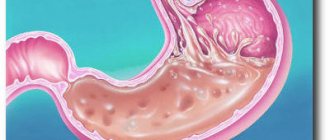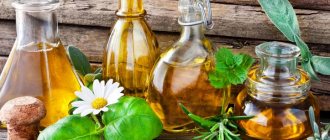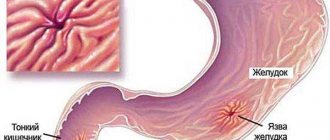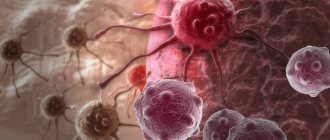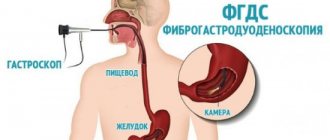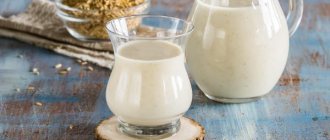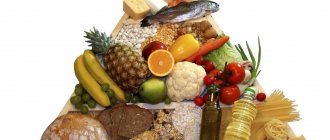10/13/201710/13/2017 Olga Migunova
Increased stomach acidity is a problem faced by half of the population of our planet. This prevalence of this disorder can be explained by the modern rhythm of life, dietary habits and the quality of the products we eat.
In this topic, we will provide you with comprehensive information about what high stomach acidity is, what the symptoms are and treatment for this pathology.
General information
The main component of gastric juice is hydrochloric acid .
Its acidity is measured by its pH level. Gastric juice also contains other acids, including lactic acid, but their concentration is too low. With certain functional disorders in the body, the pH of the gastric juice fluctuates in one direction or another. For example, with an infection or dysfunction of the stomach, an increase in the pH of hydrochloric acid is observed. In this case, they speak of increased acidity of gastric juice. Also, with gastritis , the production of hydrochloric acid increases, which leads to an increase in the acidity pH of gastric juice. The pathology is accompanied by heartburn , which can be either short-term or chronic.
Healing exercise
When treating zero acidity, physical exercise plays a significant role, which helps to establish normal functioning of the stomach and increase the level of chloride acid produced. There are no difficulties in performing the exercises; it is enough to periodically make rotational movements to the sides with your limbs bent at the knees. The position during this exercise should be horizontal with the buttocks pressed to the floor. You need to place your arms along your body and tighten your abdominal muscles.
A good effect is obtained after performing an exercise called “cat stance”. To do this, lie on your stomach and rest your palms on the floor at chest level. The torso must be periodically raised up, alternately bending the back down and straightening it up. You need to repeat this exercise 20 times. Bends of the torso in all directions and squats will be useful. When performing therapeutic exercises, you should not overload yourself and strain your abdominal muscles.
Causes of high stomach acidity
The most common cause of increased stomach acidity is irrational and unhealthy diet. Fatty, fried, spicy and salty foods, as well as alcohol-containing drinks, irritate the gastric mucosa. In response to irritation, the parietal cells of the stomach begin to intensively produce more hydrochloric acid.
The habit of eating food too quickly also has a negative impact. An insufficiently moistened with saliva, poorly chewed food bolus that contains too large particles enters the stomach. To digest such food, the stomach walls are forced to produce more hydrochloric acid than during normal nutrition. Increased production of hydrochloric acid increases the acidity of gastric juice.
Other causes of increased acidity in the stomach:
- long-term treatment with drugs from the NSAID group;
- negative impact of chronic stress;
- smoking, nicotine has a stimulating effect on parietal cells;
- Helicobacter pylori, when the Helicobacter bacteria enter the stomach, they begin to produce urease, which has an irritating effect on the mucous walls of the stomach; in response to irritation, a powerful release of hydrochloric acid and pepsin .
Consequences of increased acidity
When the acid-base balance (equilibrium) is disturbed, the following unpleasant consequences for the body are likely to develop:
- decrease in cell regenerative capacity
- decrease in the body's defenses
- joint pain
- recurrent headaches
- stool disorders
- metabolic disorders
- various allergic manifestations
The average pH should be 7.40. Pharmacies sell test strips that can be used to determine the acidity level.
If you eat a lot of sour foods and also disturb the body's water balance, acidification processes occur. As a result, oxygen reaches tissues and organs less efficiently. Minerals begin to be absorbed worse, and some of them are not absorbed at all, for example, magnesium, sodium, potassium and calcium. This leads to the development of vascular and heart diseases, and the immune system becomes much weaker than that of a person with a normal pH.
Increased acidity is called acidosis in medical literature. If we describe the consequences in more detail, we can highlight the following possible violations:
- gaining extra pounds of weight
- a favorable environment is created for the development of bacteria, viruses, parasites and fungi
- sand collects in the kidneys, stones form
- DM develops (diabetes mellitus)
- the harmful effects of free radicals increase, which is why the risk of getting cancer becomes higher
- appetite worsens, there is a risk of developing such a dangerous disease as anorexia
- weakness in the body, even if the person is well rested
- problems falling asleep
- nervous excitability
- bones become brittle (because the body tries to normalize the pH level by taking calcium from its own bones)
Symptoms of high stomach acidity
The leading symptom is epigastric pain. The pain syndrome is dull, aching in nature and most often occurs 1.5-2 hours after eating. There are also so-called hunger pains that occur before eating. Patients may complain of heartburn , which occurs in response to the consumption of foods that increase the acidity of gastric juice: tomato juice, smoked meats, mineral water (some types), orange juice, spicy or fatty foods.
Signs of high acidity:
- nausea up to vomiting, occurring 15-20 minutes after eating;
- belching with sour contents;
- often disturbing intestinal colic;
- deposition of a grayish-white coating on the root of the tongue.
With low stomach acidity, the following is noted:
- belching with a specific putrid odor;
- pain in the epigastric region immediately after eating;
- rumbling in the stomach, hiccups;
- increased flatulence , bloating in the abdomen;
- stool disorders and other symptoms.
How to find out if your stomach acidity is high or low
At home, using a simple test, you can determine what acidity you have. To do this, dissolve a quarter teaspoon of soda in a glass of cold water and drink it in the morning on an empty stomach. If you burp after a few minutes, it means you have high acidity. In the absence of belching, it can be assumed that the acidity is low. A more accurate result can be determined using pH measurements.
Symptoms
The clinical picture of this pathological process at the initial stage of development can be asymptomatic. As the disease worsens, the following symptoms may appear:
- pain and discomfort in the epigastric region, unpleasant sensations can radiate to the back;
- heaviness in the stomach;
- belching with an unpleasant odor;
- heartburn;
- bad breath;
- metallic taste in the mouth;
- prolonged constipation. The stool may contain mucus and undigested pieces of food;
- nausea, which is often accompanied by vomiting. Vomit may contain mucus, bile, and blood impurities;
- sudden weight loss accompanied by frequent vomiting and diarrhea, loss of appetite;
- abdominal pain, which is most often localized in the abdominal cavity;
- bloating, increased flatulence;
Against the background of such a clinical picture, an exacerbation of existing diseases or the development of pancreatitis, cholecystitis and other gastroenterological ailments with a similar etiology may be observed.
These clinical manifestations are the main predisposition for a visit to a gastroenterologist. Consultation with other specialists may be necessary.
Tests and diagnostics
Methods to detect increased acidity of gastric juice:
- Intragastric pH-metry . A special device allows you to measure acidity in various parts of the stomach. The study is designed for both short-term and daily pH measurements.
- Fractional intubation of the stomach . The study is performed on the patient on an empty stomach. A thick probe is inserted into the stomach through the mouth and the gastric contents are sucked out at certain intervals using a Janet syringe. Probing of the stomach allows you to find out the characteristics of the secretory function and carry out a laboratory study of gastric juice, to find out its acidity pH level. The disadvantage of the study is the mixing of juices from different parts of the stomach during probing; moreover, the probe itself has an irritating effect on the mucous wall, which can cause a false result. The normal content of hydrochloric acid in gastric juice is 0.4-0.5%.
- Acidotest (gastrotest) . Before the study, the patient is asked to completely empty the bladder and take a special medicine. After a certain period of time, the patient is asked to urinate and the acidity of gastric juice is assessed by the degree of coloration of the urine. The test is considered imperfect and is currently practically not used in modern diagnostic and treatment institutions.
Decoctions and infusions
How to treat stomach acidity? The remedies described in this chapter will help reduce the manifestations of high acidity. One of them is sea buckthorn infusion. 4 tablespoons of berries are poured with two cups of boiling water and left for a while. Consume in small portions throughout the day. You can combine the drink with honey.
It is also recommended to prepare a decoction of calendula, cinquefoil and yarrow flowers. The herbs are mixed in equal quantities. 4 large spoons of raw material are combined with a glass of boiling water. Place the mixture on the fire and heat it up. After the mixture boils, it must be boiled for a few more minutes. Then you should cool and strain the broth. It is taken in small portions 4 times a day. It is recommended to warm the product before use.
The following medicine helps reduce the concentration of hydrochloric acid in the stomach. St. John's wort, valerian, marsh grass, tansy flowers and crushed orange zest are mixed in equal proportions. 100 g of the resulting mass is poured with 1 liter of red wine. Keep in a warm place for three weeks. Take two small spoons of the product before bed.
Treatment of high stomach acidity
Treatment of high acidity includes taking medications from the following pharmacological groups:
- Proton pump inhibitors . The tablets suppress the production of hydrochloric acid by the parietal cells of the stomach by blocking H+/K+-ATPase ( Nolpaza , Ultop , Omeprazole , Pantoprazole ).
- H2-histamine receptor blockers . The drugs reduce the production of pepsin and hydrochloric acid due to a blocking effect on receptors ( Cimetidine , Ranitidine ).
- Antacids . They have a neutralizing effect on hydrochloric acid, eliminating pain, epigastric discomfort and heartburn ( Rennie , Gastal , Phosphalugel , Almagel ).
- M1-cholinergic receptor blockers . The drugs have gastroprotective properties, which is achieved by inhibiting the secretion of pepsin and hydrochloric acid ( Gastroceptin ).
- Antibiotics . Antibacterial agents are used to suppress the activity of Helicobacter pylori ( Clarithromycin , Amoxicillin , Metronidazole ).
Patients with severe pain are prescribed local anesthetics (tablets containing Anestezin Novocaine solution ) and antispasmodics ( No-shpa , Papaverine ). To obtain the maximum effect from treatment, the patient is prescribed a special diet containing both permitted and prohibited foods.
With increased acidity, alkaline mineral water has a positive effect. Under its influence, acid is neutralized and the composition of gastric juice is normalized. To get rid of high acidity, mineral water should be drunk hot. During heartburn, mineral water should be taken in small sips to relieve an attack. Alkaline types of mineral waters are enriched with bicarbonates, which neutralize the aggressive effects of gastric juice on the mucous membranes.
High acidity can be cured with an integrated approach: taking medications, changing lifestyle, following a diet, using traditional methods (honey, soothing and healing herbs).
Basic nutritional recommendations
Patients suffering from this disease must strictly adhere to the rules regarding diet. How to get rid of high stomach acidity forever? To do this, you must follow these recommendations:
- Do not consume food or drinks that are too cold or too hot. Food and water should be warm.
- The patient's diet should include first courses (without frying). It is better to use pureed vegetable soups.
- Meat or fish dishes must be steamed. Porridge (for example, oatmeal) is cooked with the addition of water, not milk.
- Eggs and cottage cheese can be eaten rarely and in small quantities.
- You should avoid soda and drinks containing caffeine and ethanol.
Medicines
- Rennie;
- Amoxicillin;
- Clarithromycin;
- Gastal;
- Omeprazole;
- Papaverine;
- Gastroceptin;
- Gaviscon.
Norm
The acidity level differs in different parts of the stomach in a healthy person. This is due to the fact that parietal cells, which produce hydrochloric acid, are located mainly in the area of the body and bottom of the organ. And most of the secretory cells that produce bicarbonates and mucus are located immediately before the entrance to the duodenum.
There are also age differences. In newborns, acidity significantly reduced , which is due to the nature of their nutrition and the low activity of parietal cells. Starting from the first days of life, it gradually increases, and already at 3-4 months it reaches adult levels.
Standard indicators of acidity in various parts of the stomach are collected in the following table:
| Index | Norm, pH |
| Gastric lumen on an empty stomach in adults (basal acidity) | 1,5-2 |
| Antrum | 1,6-7,3 |
| Vault | 1,0-4,6 |
| Back wall | 1-1,8 |
| Front wall | 0,9-1,4 |
| Deep in the epithelial layer | 5,8-7,7 |
| The lumen of the body of the stomach on an empty stomach in newborns | 4,2-6,6 |
Deviation from the norm has many negative consequences for the patient:
- increased risk of developing an inflammatory process or a defect in the mucous membrane of the stomach or duodenum;
- disruption of the functioning of stomach enzymes (pepsin, lipase), which slows down the digestion process;
- increased or decreased motility of the digestive tract;
- increased risk of developing intestinal infections and food poisoning;
- changes in the functioning of the pancreas.
First aid for hyperacidity
Antacids help neutralize the aggressive effect of hydrochloric acid, which is the main component of gastric juice. Simple soda has a similar effect. Soda does not have a cumulative effect; it has a one-time effect, neutralizing the acid present in the stomach. However, the powder contains sodium, which may have a negative effect on the course of some cardiovascular diseases.
Antacid medications contain magnesium, aluminum, bismuth and other components that have additional effects:
- antiseptic;
- antibacterial;
- regenerating.
Antacids are available in the form of a thick gel and in tablet form. Medicines envelop the mucous walls of the digestive tract, creating a specific barrier that protects the membranes from the pathogenically aggressive effects of hydrochloric acid. Preparations:
- Phosphalugel;
- Almagel;
- Rennie;
- Gastal.
Dangerous Kiss
– Why does chronic gastritis often worsen in the fall? After all, we eat approximately the same throughout the year.
- Not at all. In the summer, we often go on picnics, where we not only overeat on barbecue, but also indulge in alcohol. Add to this poorly washed food and food infections - and the stage is ready for an autumn aggravation. In addition, during the off-season the immune system often weakens, which can also lead to exacerbation. After all, microbes cannot be discounted as the cause of gastritis.
Fast food is not to blame, diets are of no use. The main myths about gastritis Read more
– If gastritis is often caused by microbes, does that mean you can become infected with it?
- Yes. The discoverer of Helicobacter pylori, Australian scientist Barry Marshall , conducted an experiment on himself by drinking a solution containing a culture of this bacterium and fell ill with gastritis. The bacterium can also be transmitted from person to person through dirty hands, shared utensils, or kissing.
Prevention
Prevention of high acidity is based on following simple rules:
- thorough, leisurely chewing of food;
- eating small portions;
- inclusion in the diet of foods rich in vitamins, plant fibers, microelements and protein;
- refusal of fast food;
- limiting the consumption of spicy and fatty foods;
- cessation of smoking and consumption of alcohol-containing products.
Maintaining a healthy lifestyle, adherence to work and rest schedules is important in prevention. When infectious diseases are detected, it is necessary to carry out timely and competent treatment, because inflammatory processes can disrupt the secretory activity of the mucous wall in the stomach.
A healthy lifestyle to protect your stomach health
It has long been no secret that it is impossible to consider the state of any organ in isolation from the body, because all systems are closely interconnected. That is why general health can help the stomach return to “normal” as quickly as possible.
If you want to forget about problems with acidity, then in addition to traditional treatment, engage in complete recovery - stop smoking, drinking alcohol, try to avoid stress, adjust your wakefulness and sleep patterns, move more, spend enough time in the fresh air.
Zero stomach acidity is a very serious disorder that requires immediate treatment, because complications can be quite serious. But if you are attentive to your body and consult a doctor in a timely manner, improvement will not take long. Be healthy!
Increased acidity during pregnancy
The acidity of gastric juice during pregnancy can be increased due to changes in hormonal levels, the appearance of pressure inside the abdominal cavity as a result of fetal growth, a sedentary lifestyle and a perversion of taste, which leads to the consumption of foods that irritate the mucous membranes of the stomach.
Recommendations that will help the expectant mother avoid problems with the digestive tract:
- Avoid wearing tight clothing, in particular with a tightening belt under the chest.
- Do not drink water before or during meals; drinking excess liquid stimulates the production of hydrochloric acid. The recommended time to drink is 20 minutes after eating.
- Reduce portion sizes, increase the number of snacks. This mode helps not to overload the stomach, allowing it to work calmly.
- Monitor your weight gain and take action if you gain weight too quickly. It is recommended to have dinner 3-4 hours before going to bed.
- Raise the head of the bed or choose a higher pillow.
- Do not take vitamins and dietary supplements prescribed by your doctor on an empty stomach.
What it is?
Stomach acidity is an indicator that characterizes the amount of hydrogen ions in the lumen of the organ.
Its values are most influenced by hydrochloric acid, which is produced by the parietal cells of the mucous membrane.
In addition, gastric juice contains bicarbonates, water, and various enzymes. They, as well as food or drink, can change the acidity of the stomach.
Help The unit of measurement throughout the world is the hydrogen index (pH). The acidity of pure water at a temperature of 25°C was chosen as the standard, which is 7.0. When it increases, the indicator drops to zero, and when it decreases, it increases to 15.
Acidity plays an important biological role. Due to the high concentration of hydrochloric acid, pathogenic bacteria that enter the digestive tract along with food are killed.
Also, under conditions of high acidity, pepsin is activated , an enzyme that takes part in the breakdown of proteins.
In addition, its fluctuations affect the functional activity of the pancreas and the motility of the digestive tract.
Norm
The acidity level differs in different parts of the stomach in a healthy person. This is due to the fact that parietal cells, which produce hydrochloric acid, are located mainly in the area of the body and bottom of the organ. And most of the secretory cells that produce bicarbonates and mucus are located immediately before the entrance to the duodenum.
There are also age differences.
In newborns, acidity significantly reduced , which is due to the nature of their nutrition and the low activity of parietal cells.
Starting from the first days of life, it gradually increases, and already at 3-4 months it reaches adult levels. Standard indicators of acidity in various parts of the stomach are collected in the following table:
| Index | Norm, pH |
| Gastric lumen on an empty stomach in adults (basal acidity) | 1,5-2 |
| Antrum | 1,6-7,3 |
| Vault | 1,0-4,6 |
| Back wall | 1-1,8 |
| Front wall | 0,9-1,4 |
| Deep in the epithelial layer | 5,8-7,7 |
| The lumen of the body of the stomach on an empty stomach in newborns | 4,2-6,6 |
Deviation from the norm has many negative consequences for the patient:
- increased risk of developing an inflammatory process or a defect in the mucous membrane of the stomach or duodenum;
- disruption of the functioning of stomach enzymes (pepsin, lipase), which slows down the digestion process;
- increased or decreased motility of the digestive tract;
- increased risk of developing intestinal infections and food poisoning;
- changes in the functioning of the pancreas.
What affects the pH of gastric juice?
The following factors can increase it:
- irregular or unbalanced diet;
- smoking;
- gastritis;
- presence of Helicobacter pylori infection;
- gastrinoma (benign tumor of the pancreas);
- frequent stressful situations ;
- excessive activation of the parasympathetic nervous system;
- long-term use of certain groups of medications (non-steroidal anti-inflammatory drugs, glucocorticoids);
- severe concomitant diseases or injuries that require hospitalization in the intensive care unit.
A decrease in acidity occurs due to the following factors:
- autoimmune damage to parietal cells;
- long-term malnutrition (cachexia);
- gastritis;
- presence of Helicobacter pylori infection;
- radiation therapy for malignant tumors;
- decreased thyroid function (hypothyroidism);
- cardiovascular pathologies, atherosclerotic changes in the arteries of the stomach;
- portal hypertension (increased pressure in the portal vein system due to chronic liver diseases);
- long-term use of antibiotics , cytostatics, hormonal anti-inflammatory drugs.
Symptoms
An increase or decrease in acidity is accompanied by various symptoms of digestive disorders. Their severity is more pronounced in childhood and young age. In elderly patients, detecting them is quite problematic:
| Symptoms of increased acidity | Symptoms of low acidity |
|
|
How to check PH?
There are various methods for determining pH levels. Some of them are widely used in clinical practice and have become the diagnostic standard for gastric diseases, others have experimental value or low information content.
Gastroscopy (FGDS)
FGDS is considered the gold standard for diagnosing gastric pathologies. To carry it out, it is necessary to insert a special probe (endoscope) through the mouth or nose . The procedure is done under local anesthesia of the posterior wall of the oropharynx, sedation or general anesthesia.
At the end of the endoscope there is a sensor that measures the acidity of the environment in real time. The received data is transmitted to the screen.
Please note: FGDS makes it possible to measure not only the acidity of gastric juice in various areas of the stomach , but also in the esophagus , as well as the acidity of intestinal juice in the duodenum . The study is carried out on an empty stomach, so basal acidity is measured.
In addition, the doctor has the opportunity to visually assess the condition of the gastric mucosa, and, if necessary, conduct a biopsy followed by cytological examination in the laboratory.
Help The price for determining acidity is on average 300 rubles. and is an additional analysis to gastroscopy. In order not to swallow the probe twice and to choose the most effective treatment for gastritis, we recommend that you definitely add this analysis when paying for an FGDS.
Acidotest
This research technique allows you to approximately estimate the acidity of the stomach without inserting a probe. It is used in practice if there are contraindications to FGDS (for example, recent myocardial infarction). But its accuracy is quite low, which significantly reduces the value of the Acidotest results.
The patient drinks 2 tablets of caffeine on an empty stomach, which is a stimulant of gastric secretion. Then he gives the first portion of urine, after which he is given 3 tablets of the drug to drink.
They contain a resin that, when reacted with hydrochloric acid, forms a dye. It gets into the urine and turns it scarlet.
Its intensity is compared with a special color scale , which allows you to assess the acidity of the environment in the stomach.
Acidotest
Blood analysis
Assessing the concentration of gastrin and pepsinogen in the blood allows us to approximately assess the severity of gastric secretion. Their amount in the blood is directly dependent on the level of acidity. The norm for gastrin 17 is 3-25 pmol/l, and for pepsinogen – 30-150 µg/l.
The disadvantage of the analysis is its lack of accuracy , which is often not enough to determine treatment tactics. However, laboratory blood tests to assess gastric acidity remain a promising area that many research centers are working on.
Diet for high stomach acidity
Diet for high stomach acidity
- Efficacy: therapeutic effect after 10 days
- Timing: constantly
- Cost of products: 1300-1500 rubles. in Week
Timely drug therapy can quickly improve the patient’s condition and eliminate existing complaints. heartburn and discomfort again To achieve long-term remission, it is necessary to adhere to special nutrition and diet. Ideally, healthy eating should become a habit and accompany the patient throughout his life.
Basic rules of diet for high stomach acidity:
- chewing food thoroughly, eating chemically and mechanically gentle foods for the stomach;
- choose a completely balanced diet;
- fractional meals in small portions 5-6 times a day.
Patients with high acidity are advised to adhere to Diet No. 1 according to Pevzner:
- products are prepared only by boiling or stewing;
- dishes are served pureed and warm;
- products that increase the secretion of hydrochloric acid are excluded (raw fruits and vegetables, spices, sauces, chocolate, strong tea, dairy products, baked goods).
Herbal products
Speaking about how to get rid of high stomach acidity, it should be noted that there are many traditional methods that help cope with this problem. However, it must be remembered that they are only an addition to the medications prescribed by the doctor. Before using herbal remedies, you should consult your doctor. To reduce the concentration of hydrochloric acid, use:
- Carrot juice. One glass of drink a day will help get rid of the manifestations of pathology.
- Mineral water. Its regular use helps reduce the concentration of hydrochloric acid in the stomach. The product is drunk before each meal. The optimal single dosage is half a glass. It is better to use slightly warmed water. To reduce symptoms, the drug is used for four weeks.
- Potato juice. It is drunk on an empty stomach or before going to bed. The optimal course of treatment is 10 days. The product must be freshly prepared.
- Honey. The product is combined with warm water in an amount of 0.5 liters. Take the product before meals in small quantities. The optimal course of treatment is two months.
- Fresh plums. Experts recommend eating at least 200 g of this product per day. You can replace fruit with plum juice.
- Mumiyo. This product is sold in any pharmacy. It usually does not have side effects. 1 g of mumiyo is combined with a glass of slightly warmed milk. Take the medicine thirty minutes before meals. The course of therapy is four weeks (if necessary, it can be repeated after 10 days).
- Sea buckthorn oil. It is placed in cool water. Pour the mixture into a hermetically sealed container. Then the container must be shaken. Collect oil from the surface of the water. The drug is taken 1 teaspoon twenty-five minutes before meals three times a day.
- Pumpkin. This product is boiled or baked. Consume thirty minutes before meals, in amounts from 30 to 150 g per day, gradually increasing the dosage.
- Egg shells. It is consumed in ground form, 2 tablespoons per day.
Consequences and complications
Increased acidity can lead to the development of severe and difficult to treat complications. When acidic and aggressive contents from the stomach enter the esophagus, its mucous membranes are damaged. The patient notes a burning sensation in the chest and discomfort. With long-term gastrointestinal reflux ( GERD ), ulcerative lesions of the esophagus are formed with the risk of their degeneration into a malignant neoplasm.
High acidity gastric juice can have a damaging effect on the mucous walls of the digestive tract. First, erosions form; with further aggressive action of hydrochloric acid, the defect grows deeper with the formation of ulcers. The stomach and duodenum may be affected.
In the absence of adequate therapy, complications develop such as:
- gastritis of the stomach with high acidity;
- ulcer perforation;
- stomach bleeding ;
- peritonitis.
Drugs
To eliminate digestive problems, the patient is prescribed enzyme preparations. Zero acidity can be eliminated by using enzymes that improve digestion. The use of medicinal herbs has a good effect, but for greater effectiveness these remedies must be used for a long period of time and often repeat the course of therapy. Doctors also use drugs that can replace hydrochloric acid.
Anacidic gastritis cannot be ignored, since without timely treatment the disease becomes severe, the process of eating becomes more complicated and there is a possible risk of complications.
What affects the pH of gastric juice?
The following factors can increase it:
- irregular or unbalanced diet;
- smoking;
- gastritis;
- presence of Helicobacter pylori infection;
- gastrinoma (benign tumor of the pancreas);
- frequent stressful situations ;
- excessive activation of the parasympathetic nervous system;
- long-term use of certain groups of medications (non-steroidal anti-inflammatory drugs, glucocorticoids);
- severe concomitant diseases or injuries that require hospitalization in the intensive care unit.
A decrease in acidity occurs due to the following factors:
- autoimmune damage to parietal cells;
- long-term malnutrition (cachexia);
- gastritis;
- presence of Helicobacter pylori infection;
- radiation therapy for malignant tumors;
- decreased thyroid function (hypothyroidism);
- cardiovascular pathologies, atherosclerotic changes in the arteries of the stomach;
- portal hypertension (increased pressure in the portal vein system due to chronic liver diseases);
- long-term use of antibiotics , cytostatics, hormonal anti-inflammatory drugs.
